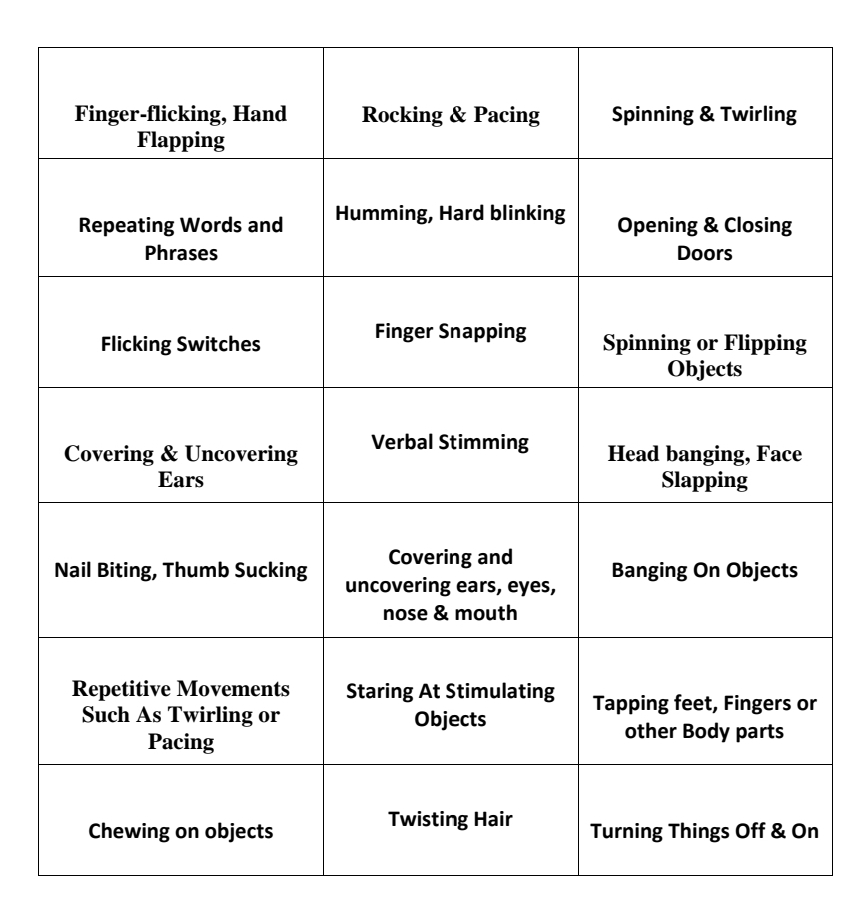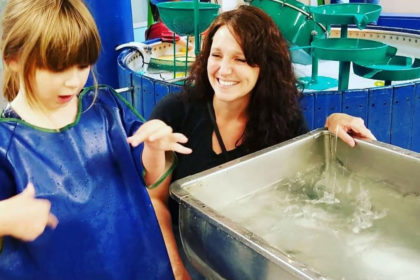Stimming Behaviors Associated With Children On The Spectrum
Auditory, Tactile/Touch, Taste/Smell, Verbal, Movement
Big Question, Should I stop my child’s stimming?
Definitively not, unless the self-stimulation behavior is impacting learning and harmful to your child or others. Often children on the Autism spectrum reduce stimming behaviors as they get older, which I have noticed a little less pacing and hand stimming from my daughter as she has aged. It’s hard as a parent to not try and stop them but so necessary to let them release their happiness and stress in a way that helps. There are many adults with Autism that have stated, withholding from stimming can be very stressful and impact their thinking process. Last thing I want for my child.
Brooklyn and I often venture to the giant tower bell in downtown Vancouver. She loves the anticipation of it going off. With lots of pacing back and forth, moaning sounds of excitement and hands up on her face. Getting her to sit and wait patiently is a key thing I have been working with her on. My biggest concern during a situation like this, is her unawareness of what is happening around her. She is so en-tuned into the world of the bell, that running into people, stepping off the side of a sidewalk or tripping are common.
The meltdowns when it’s time to leave the bell have been some of the hardest. If the bell does not go off before its time to go then the fighting me begins. No way can we leave before it goes off. She will plant to the ground, hands over ears, screaming, running from me and so much more. But…..don’t worry I have figured out a solution! I pull up a video online of the Downtown Vancouver bell going off, play it load and hold it super close behind her. Her excitement amplifies, we listen to the 2 minute video and then she is alright to leave. As I said before, try to assess and figure out why they are upset and if there is a way to address it. So worth it, calming the situation saves yourself some tears and stress.
When Squirmies & Wiggles Affect School
Sometimes it’s hard for kids to focus in school. When kiddos get the squirmies and the wiggles, it makes it difficult for them to focus on the material in front of them. In recent years we have had a huge rise is adaptions made for special needs children. There are a lot of items available on the market to help kids self-stimulate in order to calm the moment on hand. Fidgeting helps to focus and listen so much easier.
As your child gets older they may try to suppress stims just to better fit in with peers. If you notice this happening then it may be best to try and talk thru it and have the school offer some alternative options. As long as the stimming is helping the child release some stress then allowing it is crucial. Schools often do not want loud stimming gadgets in a classroom but should accommodate things such as stress balls, fidget cubes, spinners, gum, (which helps my daughter) stim necklaces, and the best option I think for even adults is a foot massage mat. How could we resist.
A Few Great Sensory Options For School Setting
What if I am overwhelmed? The biggest thing to do is just be patient and calm and try to understand better what is triggering these behaviors. Try keeping a list of different behaviors over a few weeks. Noting what happens before and after the behavior. If you better understand what causes your child’s self-injurious and aggressive behavior, then you can help your child learn to manage the behavior so much more. However, sometimes controlling your child’s energy level, emotions and behaviors is to much to handle alone. If you feel as if your child’s stims are harmful or inappropriate then more support from others may need to be implemented.
What should I do next? Look into these options below and see if they are a good fit.
Occupational therapists can help you look at environmental adjustments to support your child. A psychologist or ABA therapist can do an applied behavior analysis to see what behavior interventions might be able to help. These are a few things they will be taking a look at, then evaluate what needs to be addressed and implemented.
Key things to talk with them about are as follows:
ABA therapy and analysis options- involving positive reinforcement for good behaviors and consequences for negative ones. This is applied in a nice manner and patience is taught. I learned so much from watching the therapist work with my daughter.
Sensory diet- a group of specific activities will be scheduled into your child’s day to assist with attention, arousal and adaptive responses. The activities are chosen for that child’s needs based on sensory integration evaluation.
Environmental changes- Changing the environment can often reduce behavioral episodes. Making things more comfortable in the home, school and childcare center if possible. Try to adjust and avoid situations that trigger the challenging behavior. If possible, try to adjust or avoid situations that are triggers for challenging behavior. Incorporate ways to reduce frustration and anxiety and increase understanding. Such things as soundproofing windows, removing textures or light that bother them and offering a smaller classroom if needed.
Stress management tools- These things would be items such as above. things introduced to help with the stressful moments. Stress balls, swing set, sound-blocking headphones are just a few options.
Medication options- Obviously medication is not always the first route but has been said to help with irritability and aggressiveness. If needed it is worth talking with the doctor to evaluate options.
I hope after reading this article that it has helped you better relate to the moments you may be experiencing. If so then make sure and click some links below and keep on researching options to better the life of you and your child. Worth the effort I promise!!
https://www.autismparentingmagazine.com/overstimulation-autism/
https://www.autismspeaks.org/tool-kit-excerpt/adapting-your-environment
https://www.verywellhealth.com/what-is-stimming-in-autism-260034








ordering enclomiphene canada over the counter
non generic enclomiphene no prescription
get androxal buy in london
cheapest buy androxal buy mastercard